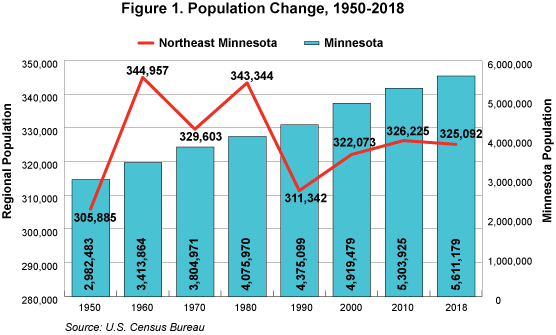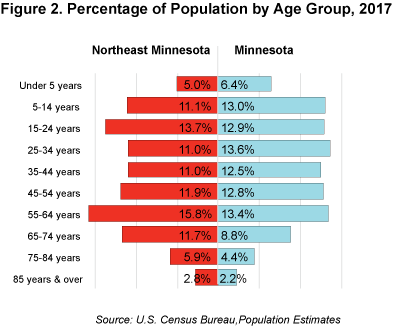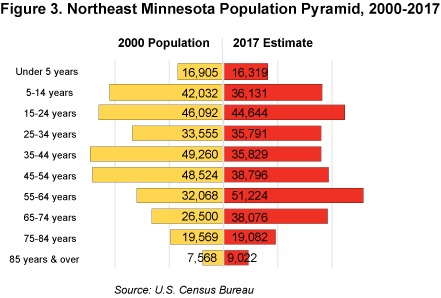
by Erik White
June 2019
Population growth is vital to economic expansion.
In 2018, just over 325,000 people resided in the seven-county Arrowhead region, considerably less than the high-water mark of the 1960s and 1980s when nearly 345,000 people lived here. What's more, Northeast Minnesota has recorded further population declines so far this decade while Minnesota as a whole has gained over 307,000 new residents (Figure 1). In fact, the region lost just over 1,100 people since 2010, a 0.3 percent decline and the second largest loss of any region in Minnesota behind Southwest Minnesota.

Without population increases the region will be hard-pressed to support economic expansion as industries have a hard time finding new workers for growth. Not only is population growth – or the lack of it – a pronounced problem in the region, but the age of the population has the potential to stifle economic growth, as well.
In Northeast Minnesota, 36.2 percent of the population is 55 years or older, compared to just 28.8 percent of the state's population. This age cohort of soon-to-be or already retired persons has dramatically increased since 2000 and explains the difficulties employers experience in replacing retiring workers. In 2000, there were 32,068 people in the region who were 55 to 64 years old, but that age group has increased by nearly 60 percent – or 19,156 people – since then. Likewise, the number of people age 65 and older in Northeast Minnesota has increased by 12,543 people since the start of the century, up 23.4 percent.
The youngest age cohorts provide more signals of future hiring difficulties for Northeast Minnesota. Just 16.1 percent of the population is under 14 years of age, considerably less than the 19.4 percent statewide. In 2000, there were 58,937 people in this age cohort in Northeast, but now there are only 52,450 people 14 years and younger, a decrease of 6,487 people or 12.4 percent. Fewer young people means it will continue to be difficult to replace retiring workers, and efforts will be needed to attract new residents to ensure economic stability (Figures 2 and 3).


Projections from the Minnesota State Demographic Center show that these trends will continue into the foreseeable future. The total population for the Arrowhead region is expected to decrease to around 320,000 people by 2040, a 2.3 percent decrease. Meanwhile, Minnesota is projected to grow in total population by 8.8 percent, with a gain of over 500,000 people, during the same time frame.
Moreover, the population will continue to age. By 2020 there will be 77,737 people in the region who are 65 and older, and by 2040 that number is expected to rise by another 15,753 people, a 20.3 percent increase. Furthermore, the growth is concentrated at the older end of the distribution with the population 75 and older expected to almost double between 2020 and 2040.
Unless labor force participation rates increase greatly, an increase in population in the oldest age cohorts will constrict economic growth as people retire during the next 20 years without the same number of people coming into the workforce as new entrants (Figure 4).

There are consequences of a declining and aging population on the economy, as evidenced by DEED's 2016 to 2026 employment projections. Overall, the Arrowhead region is projected to grow by 1.1 percent with an increase of 1,725 jobs by 2026, the second lowest growth rate of Minnesota's six planning regions (Table 1). Northeast growth lags considerably behind projected statewide employment growth of 5.9 percent. Without population growth, it may be difficult to accommodate job growth, but some sectors are projected to do better than others.
| Table 1. Industry Projections for Northeast Minnesota, 2016-2026 | |||||
|---|---|---|---|---|---|
| NAICS Code | Industry | Estimated Employment 2016 | Projected Employment 2026 | Percent Change 2016 - 2026 | Numeric Change 2016 - 2026 |
| 0 | Total, All Industries | 160,337 | 162,062 | +1.1% | +1,725 |
| 62 | Health Care and Social Assistance | 32,797 | 36,322 | +10.7% | +3,525 |
| 54 | Professional and Technical Services | 4,365 | 4,944 | +13.3% | +579 |
| 72 | Accommodation and Food Services | 14,654 | 15,094 | +3.0% | +440 |
| 21 | Mining | 3,610 | 4,044 | +12.0% | +434 |
| 81 | Other Services, Ex. Public Admin. | 6,845 | 7,093 | +3.6% | +248 |
| 56 | Administrative and Waste Services | 3,602 | 3,776 | +4.8% | +174 |
| 71 | Arts, Entertainment, and Recreation | 3,522 | 3,680 | +4.5% | +158 |
| 52 | Finance and Insurance | 4,954 | 5,069 | +2.3% | +115 |
| 53 | Real Estate and Rental and Leasing | 1,332 | 1,435 | +7.7% | +103 |
| 61 | Educational Services | 12,988 | 13,044 | +0.4% | +56 |
| 55 | Management of Companies | 828 | 821 | -0.8% | -7 |
| 22 | Utilities | 1,489 | 1,440 | -3.3% | -49 |
| 11 | Agriculture, Forestry, Fishing and Hunting | 1,875 | 1,694 | -9.7% | -181 |
| 48 | Transportation and Warehousing | 4,727 | 4,528 | -4.2% | -199 |
| 51 | Information | 1,589 | 1,343 | -15.5% | -246 |
| 23 | Construction | 6,380 | 6,068 | -4.9% | -312 |
| 42 | Wholesale Trade | 3,278 | 2,931 | -10.6% | -347 |
| 92 | Public Administration | 14,724 | 14,358 | -2.5% | -366 |
| 31 | Manufacturing | 8,473 | 7,725 | -8.8% | -748 |
| 44 | Retail Trade | 17,625 | 15,875 | -9.9% | -1,750 |
| Source: DEED Employment Outlook 2016 to 2026 | |||||
On the plus side, an aging population will create stronger demand for health care services, and this sector is expected to gain the most jobs in the area. Health care and social assistance is projected to grow by 10.7 percent with an increase of 3,525 jobs to reach a total of 36,322 jobs, constituting 22.4 percent of all employment in the region. Another large sector expected to gain jobs is Accommodation and Food Services, with an increase of 440 jobs by 2026. Professional and Technical Services is projected to increase by 13.3 percent with an increase of 579 jobs. Finally, as new ventures continue to move forward and the industry rebounds from its slowdown, Mining is expected to see high employment growth.
While 10 of the 20 industry sectors are projected to gain jobs, the other half are projected to decline, including some high employment industries. Retail trade is projected to lose 1,750 jobs by 2026, a nearly 10 percent decline in total employment. Manufacturing is expected to lose 748 jobs, and construction is projected to cut nearly 5 percent of its workforce with the loss of 312 jobs.
Employment projections show that some sectors will be hit hard due to economic factors and demographic trends while some sectors are likely to experience growth. But this growth will only happen if Northeast can attract and retain residents. If not, the region's declining and aging population will stress the local economy and inhibit growth.